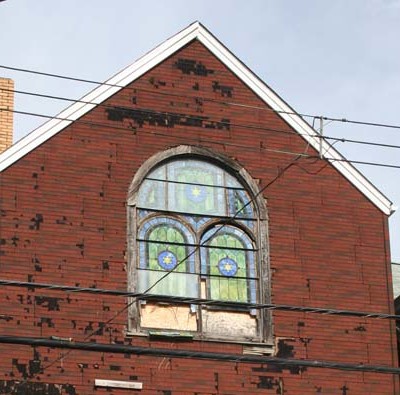
The United States Glass Company acquired a plot of land along the Monongahela River south of McKeesport, Pa., in 1894 and called the site of its new mill Glassport. Glassport, Pa., was incorporated as a borough in 1902, when it separated from neighboring Port Vue. Although never large, Glassport became an important industrial hub and even had oil and natural gas production for a time.
Jewish families began settling in Glassport in the early 20th century. B’nai Israel Congregation was organized by approximately 13 Jewish families at a meeting on September 29, 1906, according to a 1976 local history of Glassport entitled It Happened Here. The first president was a grocer named Charles Weisenthal, and early members included Max Broder, Jacob Lazar, Sam Miller, Ben Perlstein, Max Papernick, A. A. Raden, Joseph Shear, Meyer Weiss and Saul Weiss. Congregants met at Furman’s Hall until 1910, the Glassport Bank Building until 1912 and Gross Hall until 1916, according to a March 1940 survey by the Works Progress Administration Church Archives. A historic overview of Glassport in the June 30, 1934 issue of the McKeesport Daily News suggests that the congregation met exclusively at Furman’s Hall in these years.
B’nai Israel was officially chartered in 1914. The congregation built a modest synagogue in 1916 on land purchased by the local Ladies’ Aid Society, according to It Happened Here. The synagogue was located on Ohio Avenue, between 5th and 6th streets. It was a gray, two-story frame building of “no particular style” with “no unusual features,” according to the Works Progress Administration survey. A stained glass window on the front façade included a motif of tablets and Stars of David. The congregation lifted the building in 1935 to add a basement. As of June 2017, the building was still standing.
B’nai Israel established a Ladies’ Aid Society by 1919 and appears to have organized a branch of the Southwestern District of Pennsylvania Jewish Religious Schools program by 1922, but the Jewish population of Glassport relied on the much larger community nearby McKeesport for some needs, such as its B’nai B’rith lodge. B’nai Israel in Glassport had at least seven rabbis during its first 30 years.
The Jewish population of Glassport grew through the first four decades of the 20th century and started to decline after World War II, according to population figures from the American Jewish Yearbook. The yearbook listed a population of 120 in its 1918-1919 edition, 140 in its 1928-1929 edition, 210 in its 1940-1941 edition and 120 in its 1951 edition. The McKeesport Daily News history from June 1934 reported that B’nai Israel had 14 members in 1916 and 22 members in 1934, and never exceeded 29 members during its early years.
Glassport was the childhood home of Judge Samuel A. Weiss, who served in the Pennsylvania House of Representatives from 1935 to 1939 and the United States House of Representatives from 1941 to 1946 and was an Allegheny County Court of Common Pleas judge from 1946 until he retired in 1967. He was also deputy commissioner of the National Football League from 1942 to 1950. Judge Weiss returned to Glassport in February 1956 to be the toastmaster for the fiftieth anniversary of B’nai Israel.
In late 1915, Congregation B’nai Israel established a cemetery by purchasing seven plots at the Elrod Cemetery from Temple B’nai Israel of McKeesport. The Glassport congregation expanded its cemetery through additional land purchases in 1933 and 1977.
The population of Glassport declined sharply after a tornado destroyed the glass mill in August 1963. Congregational recordkeeping for B’nai Israel became less frequent around the same time. The congregation secured perpetual care of its expanded cemetery in 1976 and officially sold its remaining assets in 2000.